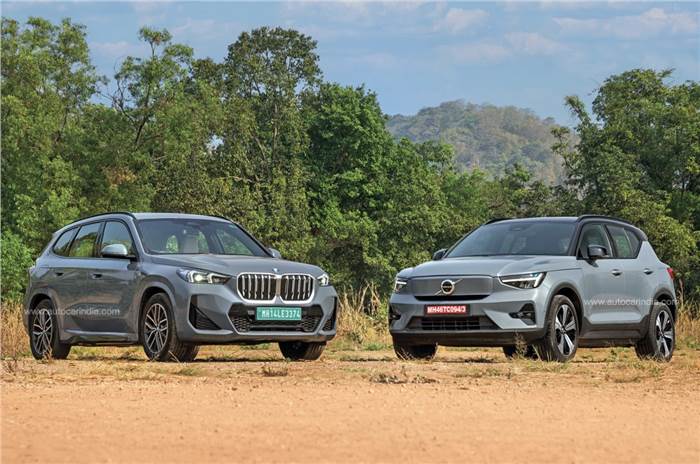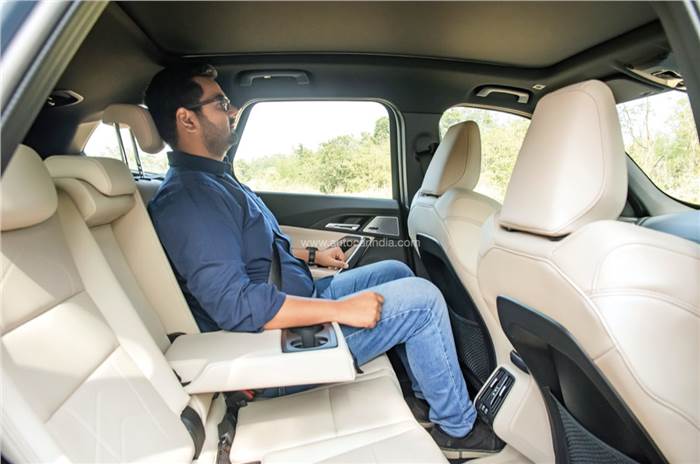BMW iX1 vs Volvo XC40 Recharge: Electric luxury starts here
With similar on-road prices as like-sized ICE SUVs, the BMW iX1 and Volvo XC40 Recharge will tempt you to go all-electric.
Published on Apr 26, 2024 11:20:00 AM
43,289 Views
Follow us on

XC40 Recharge is comfier, upright back rest notwithstanding.

Knees-up seating hampers comfort at the back on the iX1.
In the market for an entry luxury SUV? Thanks to a road tax waiver on EVs in most states, registration benefits and other concessions, the final on-road price you pay for an EV is in the same ballpark as a petrol or diesel model. The BMW iX1 (Rs 66.9 lakh ex-showroom), for instance, works out to Rs 71 lakh on-road – Rs 8 lakh more than a diesel X1. However, the added outlay also gets you double the power. Sounds like a steal, right? The even more powerful Volvo XC40 Recharge (Rs 57.9 lakh ex-showroom) actually undercuts a diesel X1! Now that you’re interested, let’s dive deeper.
BMW iX1 vs Volvo XC40 Recharge: Exterior
If you’ve seen an X1 and XC40, you’ve seen an iX1 and XC40 Recharge. The all-electric SUVs are identical to their combustion-engined siblings (the XC40 is no longer sold, mind you) in look, save for detail differences. A blue surround for the BMW badges symbolises all-electric power on the iX1, while a closed-off grille is your tell-tale sign of the Recharge being an all-electric XC40. Of course, no exhaust pipes on either SUV.
 The iX1's M Sport bumpers add sportiness to its styling.
The iX1's M Sport bumpers add sportiness to its styling.
| BMW iX1 Price, Mileage, Specifications, Features and Variants | |
|---|---|
| Brand | BMW |
| Model Name | iX1 |
| BMW iX1 Price | ₹ 76.89 lakh |
| BMW iX1 Range/Mileage | Electric : 440km |
| BMW iX1 Specifications | SUV | 5 doors | 5 seats View All Specs |
| BMW iX1 Features | LED headlight | 10.7-inch Touchscreen display | 6 airbags View All Features |
| BMW iX1 Variants | EV xDrive30 View All Variants |
The iX1 looks quite wholesome and the M Sport bumpers bring in some sportiness as well. Tail-lights that jut out are a striking detail of note. The broad-shouldered XC40 Recharge, on the other hand, has a crisp, clean cut look about it with 19-inch alloy wheels only adding to the stance. If you want your EV with more styling flair, Volvo has you covered with the C40, the XC40 Recharge’s SUV-coupe derivative.

Of other things, the Volvo has an EV-special trick up its sleeve, rather under its bonnet, with a 31-litre frunk that can be used to stow charging cables and the like. A pain point (on both SUVs), however, is the absence of a dedicated space for the spare tyre. Their spares sit on the boot floor and eat into much of the usable space.
BMW iX1 vs Volvo XC40 Recharge: Interior
Inside, it’s the BMW with a more modern, more youthful vibe. The asymmetric dash with its connected screens is fresh and the floating centre console (something typical of a born-electric, which the iX1 is not) looks fantastic too. Where the Bimmer also has the upper hand is in material quality. The interior looks and feels rich and attention to detail is up there with pricier BMWs. Also really nice are the large front seats that are supportive and pack in lumbar massage.


While both SUVs are comparable on rear seat space (they’re best for two), each has its quirks. In an iX1, rear seat occupants have to contend with a knees-up seating position and limited foot space under the front seat. The BMW’s large front seats also limit frontal visibility from the back. On the plus side, the BMW gets softer cushioning and also offers the option to adjust the backrest angle. The XC40 Recharge’s non-adjustable backrest is a touch upright but on the whole the Volvo’s seating position is nicer. However, the Volvo’s dark theme also impacts the feeling of space at the back.
BMW iX1 vs Volvo XC40 Recharge: Features
It’s a close match when it comes to features. LED headlights, powered front seats, panoramic sunroofs and premium audio systems are goodies you’d find on both. The BMW has the more vibrant digital dials and touchscreen, and the latter is also easier to navigate than the Volvo’s 9-inch portrait-oriented unit, if only just. Volvo’s Google-based interface handily allows your phone’s map to be mirrored on the digital dials. What takes getting used to is the Volvo’s starting procedure. There’s no push button operation. Rather, slotting the gear selector into drive has the vehicle come to life.
 The absence of a push-button means that the gear selector has to be used to bring the Volvo to life.
The absence of a push-button means that the gear selector has to be used to bring the Volvo to life.In terms of safety kit, the BMW offers six airbags to the Volvo’s seven. Otherwise, both get all manners of electronic driver aids, including radar and camera-based ADAS functions such as lane keep assist, adaptive cruise control and emergency braking. The features work best in smooth flowing traffic and on well marked roads.
BMW iX1 vs Volvo XC40 Recharge: Powertrains
Coming to the heart of this comparison. Both models use dual motors (one at each axle) that are powered by lithium-ion battery packs positioned under their floors. It’s when you get into the finer details that the iX1 comes across as out-specced by the XC40 Recharge. The iX1’s 313hp and 494Nm power and torque figures, respectively, are well down on the XC40’s 408hp and 660Nm. It’s the Volvo with the bigger battery too – 78kWh to the iX1’s 66.4kWh.
It’d be doing the iX1 an injustice to mark it down solely based on the numbers on paper. Because in reality it feels properly brisk. Flat-out acceleration is strong (0-100kph takes 5.6 seconds) and it feels peppy and responsive across the board. A Boost mode that (via a tug at the paddle) has the motors give their all for 10 seconds is particularly fun when you want a burst of power.

If the iX1 is quick, the XC40 Recharge is manic at max attack. The pushback on to your seat under hard acceleration is more sportscar than entry luxury SUV, as is the Volvo’s 4.9 second 0-100kph time. Even regular overtakings are so effortless, it’s as if you’re simply dismissing other vehicles. The Volvo’s thrilling performance is grin-inducing.
At high speeds and on winding roads, the Volvo drives with a heft that instils confidence, even if the steering isn’t the most feelsome. The option to increase steering weight helps the experience to some extent. In comparison, the iX1 feels more precise at the steering, but it isn’t the BMW that you’d buy for how it handles. And that’s because the iX1 doesn’t feel as well tied down as it ought to. On a patchy surface too, you’ll move around more in the BMW.
.jpg&c=0&w=700)
In more everyday urban settings, it’s the BMW that rounds off the potholes better and also offers the quieter cabin experience. The Volvo can’t suppress road and tyre noise as well as the Bimmer can (it’s still calm inside) and the suspension can also come across as clunky on the odd oversized speedbreaker.
BMW iX1 vs Volvo XC40 Recharge: Battery pack, range
The XC40 Recharge has the larger battery and the greater official range, a WLTP figure of 505km versus the iX1’s 417-440km. On our EV range test loop, we got real world city figures of 385kph and 323km, respectively. The Volvo’s 20 percent more range counts for a lot.
Regen braking chips in with charge with the BMW allowing finer selection of braking force. The Volvo’s system (there’s only coasting and one-pedal mode) can bring the vehicle to a complete halt but also feels too strong.
Both models support DC fast charging (the Volvo at up to 150kW and the BMW up to 130kW) though AC home charging will be the go to solution for most owners.
BMW iX1 vs Volvo XC40 Recharge: Verdict
Were you shopping specifically for a BMW X1, the all-electric iX1 would be our pick of the range. It’s got everything we like about the X1 while addressing the combustion engined models’ biggest weakness – lack of zing. Sure, you pay more for going electric but the added performance makes the money very well spent. Even so, the iX1 isn’t the best luxury electric SUV for the money. That would be the Volvo XC40 Recharge.

The Volvo’s not got the iX1’s flash both outside and in, but it has its own likeable persona. What tilts the scales in favour of the Volvo is its performance and range. The XC40 Recharge is thrillingly quick and the greater range courtesy its larger battery counts for a lot. Factor in a lower price tag and tad better backseat, and you get a package that’s terrific bang for your buck.
Also see:
Volvo XC40 Recharge single motor launched at Rs 54.95 lakh
Copyright (c) Autocar India. All rights reserved.





Comments
Member Login
Personal Details
No comments yet. Be the first to comment.